Business Analysis of Hair for You: Challenges, Models, and Techniques
VerifiedAdded on 2019/11/26
|7
|2236
|199
Report
AI Summary
This report presents a comprehensive business analysis of the 'Hair for You' case study, where a salon business faces challenges after a patriarch's death. The analysis identifies both soft (communication, problem-solving) and hard (lack of technology, integration) problems across the three branches managed by the owner's children. The report explores stakeholders, problem owners, and evaluates various analytical techniques like Data Flow Diagrams (DFDs), Business Process Model and Notation (BPMN), and Object-Oriented Analysis and Design (OOAD), critiquing their strengths and weaknesses. A rich picture diagram visually represents the problems and stakeholders. Finally, the report applies Blum's matrix to classify the Soft Systems Methodology (SSM) within a specific quadrant, highlighting its role in addressing the identified challenges and improving the business situation. The report utilizes various academic sources to support the analysis.
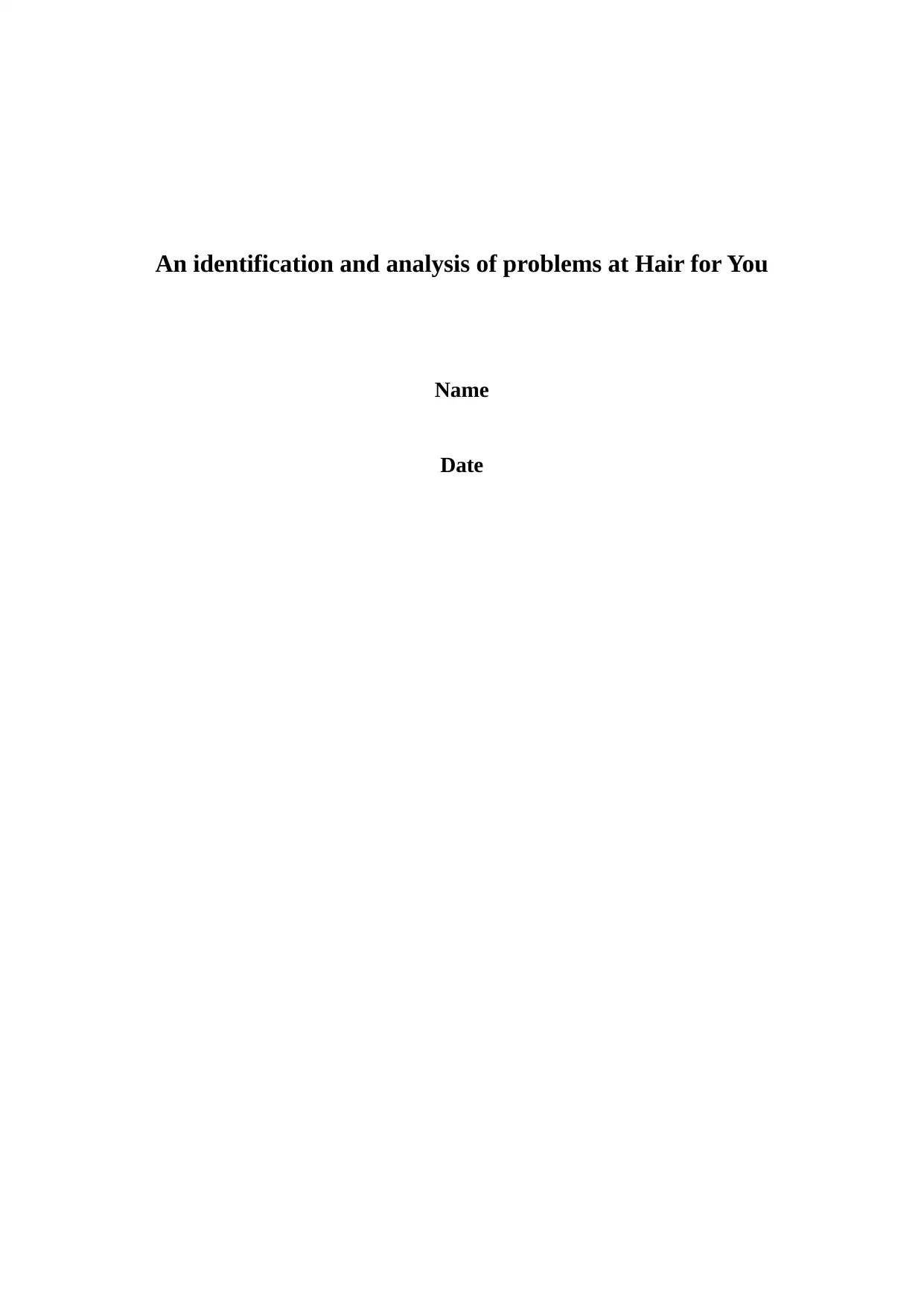
An identification and analysis of problems at Hair for You
Name
Date
Name
Date
Paraphrase This Document
Need a fresh take? Get an instant paraphrase of this document with our AI Paraphraser
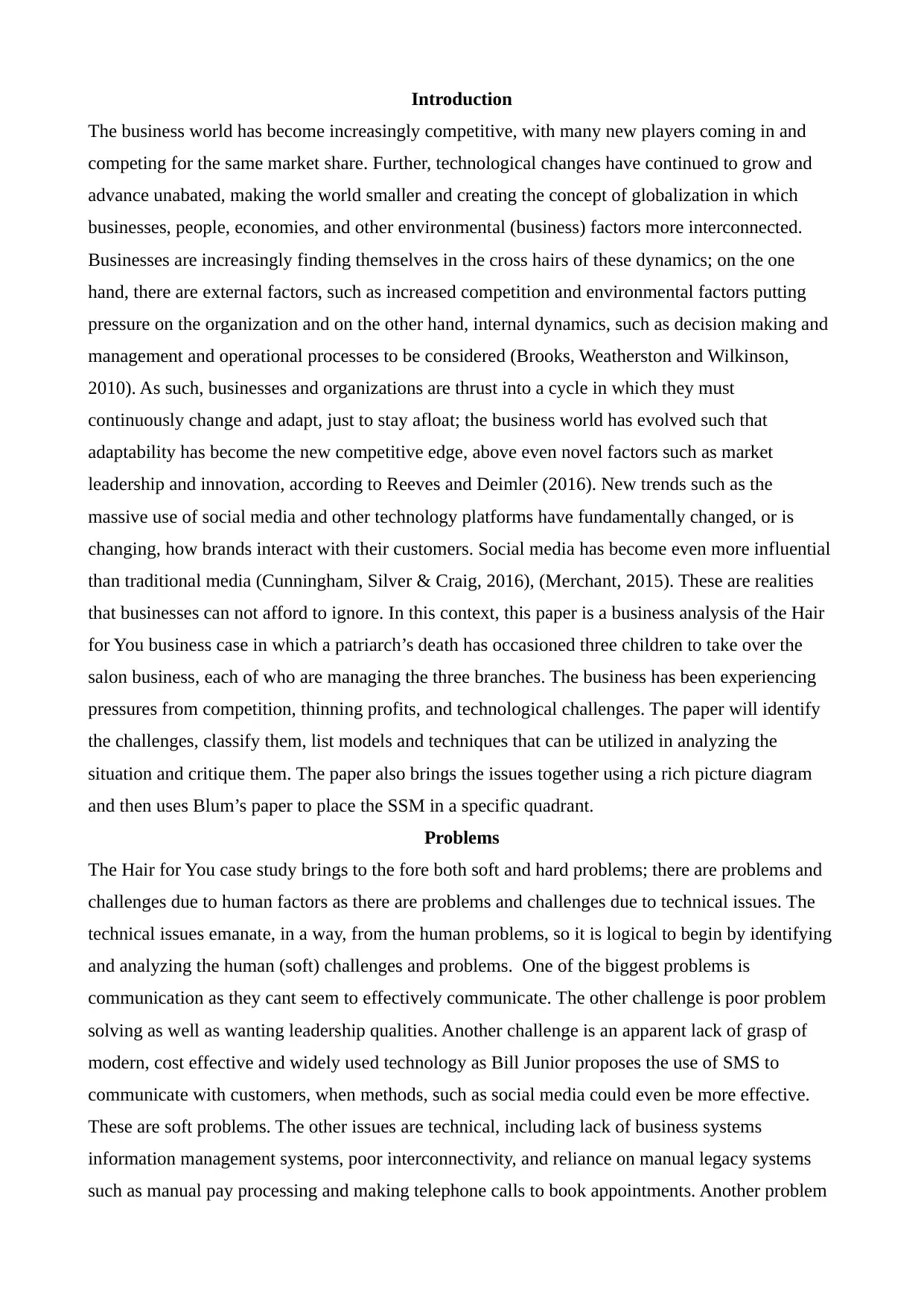
Introduction
The business world has become increasingly competitive, with many new players coming in and
competing for the same market share. Further, technological changes have continued to grow and
advance unabated, making the world smaller and creating the concept of globalization in which
businesses, people, economies, and other environmental (business) factors more interconnected.
Businesses are increasingly finding themselves in the cross hairs of these dynamics; on the one
hand, there are external factors, such as increased competition and environmental factors putting
pressure on the organization and on the other hand, internal dynamics, such as decision making and
management and operational processes to be considered (Brooks, Weatherston and Wilkinson,
2010). As such, businesses and organizations are thrust into a cycle in which they must
continuously change and adapt, just to stay afloat; the business world has evolved such that
adaptability has become the new competitive edge, above even novel factors such as market
leadership and innovation, according to Reeves and Deimler (2016). New trends such as the
massive use of social media and other technology platforms have fundamentally changed, or is
changing, how brands interact with their customers. Social media has become even more influential
than traditional media (Cunningham, Silver & Craig, 2016), (Merchant, 2015). These are realities
that businesses can not afford to ignore. In this context, this paper is a business analysis of the Hair
for You business case in which a patriarch’s death has occasioned three children to take over the
salon business, each of who are managing the three branches. The business has been experiencing
pressures from competition, thinning profits, and technological challenges. The paper will identify
the challenges, classify them, list models and techniques that can be utilized in analyzing the
situation and critique them. The paper also brings the issues together using a rich picture diagram
and then uses Blum’s paper to place the SSM in a specific quadrant.
Problems
The Hair for You case study brings to the fore both soft and hard problems; there are problems and
challenges due to human factors as there are problems and challenges due to technical issues. The
technical issues emanate, in a way, from the human problems, so it is logical to begin by identifying
and analyzing the human (soft) challenges and problems. One of the biggest problems is
communication as they cant seem to effectively communicate. The other challenge is poor problem
solving as well as wanting leadership qualities. Another challenge is an apparent lack of grasp of
modern, cost effective and widely used technology as Bill Junior proposes the use of SMS to
communicate with customers, when methods, such as social media could even be more effective.
These are soft problems. The other issues are technical, including lack of business systems
information management systems, poor interconnectivity, and reliance on manual legacy systems
such as manual pay processing and making telephone calls to book appointments. Another problem
The business world has become increasingly competitive, with many new players coming in and
competing for the same market share. Further, technological changes have continued to grow and
advance unabated, making the world smaller and creating the concept of globalization in which
businesses, people, economies, and other environmental (business) factors more interconnected.
Businesses are increasingly finding themselves in the cross hairs of these dynamics; on the one
hand, there are external factors, such as increased competition and environmental factors putting
pressure on the organization and on the other hand, internal dynamics, such as decision making and
management and operational processes to be considered (Brooks, Weatherston and Wilkinson,
2010). As such, businesses and organizations are thrust into a cycle in which they must
continuously change and adapt, just to stay afloat; the business world has evolved such that
adaptability has become the new competitive edge, above even novel factors such as market
leadership and innovation, according to Reeves and Deimler (2016). New trends such as the
massive use of social media and other technology platforms have fundamentally changed, or is
changing, how brands interact with their customers. Social media has become even more influential
than traditional media (Cunningham, Silver & Craig, 2016), (Merchant, 2015). These are realities
that businesses can not afford to ignore. In this context, this paper is a business analysis of the Hair
for You business case in which a patriarch’s death has occasioned three children to take over the
salon business, each of who are managing the three branches. The business has been experiencing
pressures from competition, thinning profits, and technological challenges. The paper will identify
the challenges, classify them, list models and techniques that can be utilized in analyzing the
situation and critique them. The paper also brings the issues together using a rich picture diagram
and then uses Blum’s paper to place the SSM in a specific quadrant.
Problems
The Hair for You case study brings to the fore both soft and hard problems; there are problems and
challenges due to human factors as there are problems and challenges due to technical issues. The
technical issues emanate, in a way, from the human problems, so it is logical to begin by identifying
and analyzing the human (soft) challenges and problems. One of the biggest problems is
communication as they cant seem to effectively communicate. The other challenge is poor problem
solving as well as wanting leadership qualities. Another challenge is an apparent lack of grasp of
modern, cost effective and widely used technology as Bill Junior proposes the use of SMS to
communicate with customers, when methods, such as social media could even be more effective.
These are soft problems. The other issues are technical, including lack of business systems
information management systems, poor interconnectivity, and reliance on manual legacy systems
such as manual pay processing and making telephone calls to book appointments. Another problem
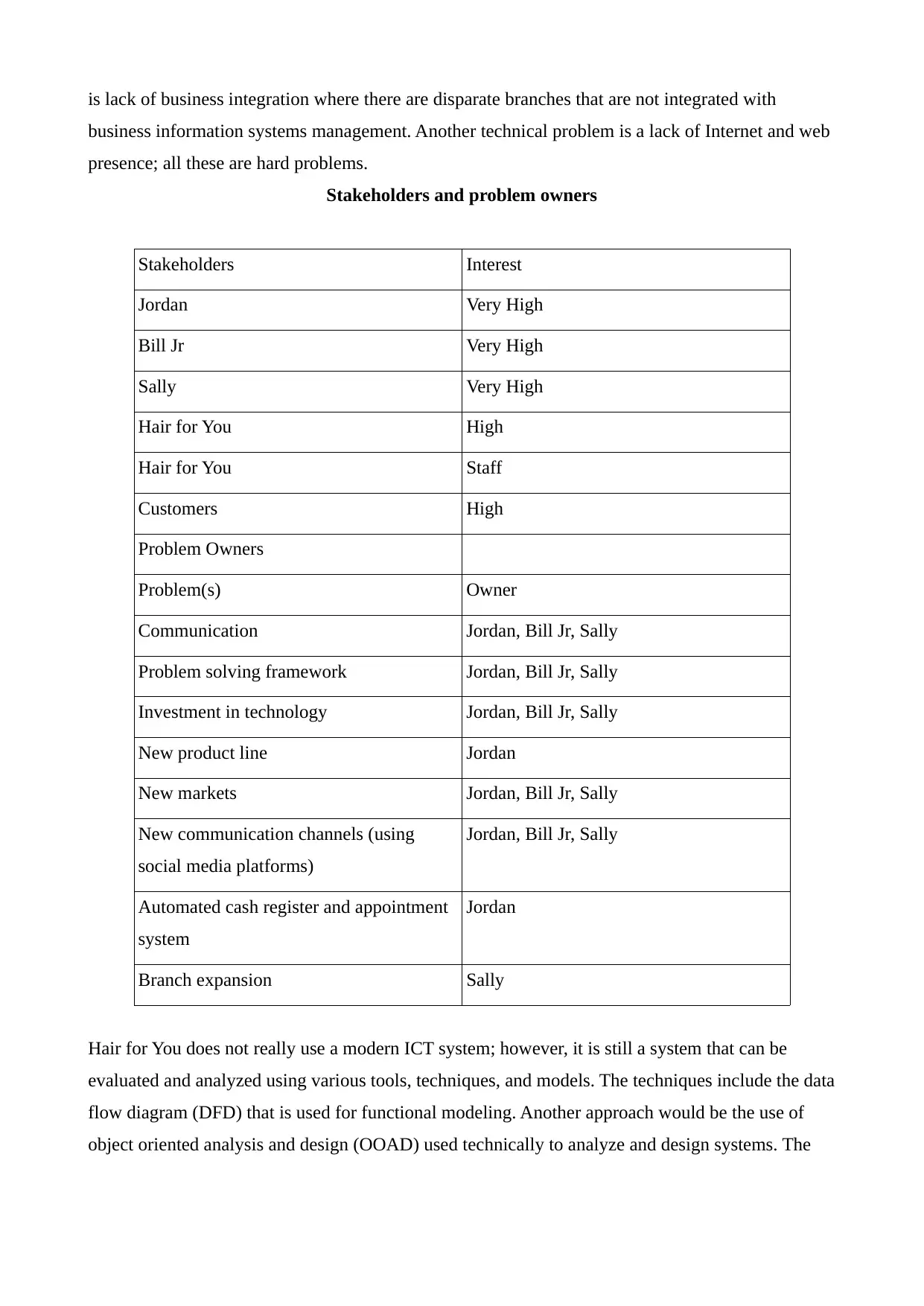
is lack of business integration where there are disparate branches that are not integrated with
business information systems management. Another technical problem is a lack of Internet and web
presence; all these are hard problems.
Stakeholders and problem owners
Stakeholders Interest
Jordan Very High
Bill Jr Very High
Sally Very High
Hair for You High
Hair for You Staff
Customers High
Problem Owners
Problem(s) Owner
Communication Jordan, Bill Jr, Sally
Problem solving framework Jordan, Bill Jr, Sally
Investment in technology Jordan, Bill Jr, Sally
New product line Jordan
New markets Jordan, Bill Jr, Sally
New communication channels (using
social media platforms)
Jordan, Bill Jr, Sally
Automated cash register and appointment
system
Jordan
Branch expansion Sally
Hair for You does not really use a modern ICT system; however, it is still a system that can be
evaluated and analyzed using various tools, techniques, and models. The techniques include the data
flow diagram (DFD) that is used for functional modeling. Another approach would be the use of
object oriented analysis and design (OOAD) used technically to analyze and design systems. The
business information systems management. Another technical problem is a lack of Internet and web
presence; all these are hard problems.
Stakeholders and problem owners
Stakeholders Interest
Jordan Very High
Bill Jr Very High
Sally Very High
Hair for You High
Hair for You Staff
Customers High
Problem Owners
Problem(s) Owner
Communication Jordan, Bill Jr, Sally
Problem solving framework Jordan, Bill Jr, Sally
Investment in technology Jordan, Bill Jr, Sally
New product line Jordan
New markets Jordan, Bill Jr, Sally
New communication channels (using
social media platforms)
Jordan, Bill Jr, Sally
Automated cash register and appointment
system
Jordan
Branch expansion Sally
Hair for You does not really use a modern ICT system; however, it is still a system that can be
evaluated and analyzed using various tools, techniques, and models. The techniques include the data
flow diagram (DFD) that is used for functional modeling. Another approach would be the use of
object oriented analysis and design (OOAD) used technically to analyze and design systems. The
⊘ This is a preview!⊘
Do you want full access?
Subscribe today to unlock all pages.

Trusted by 1+ million students worldwide
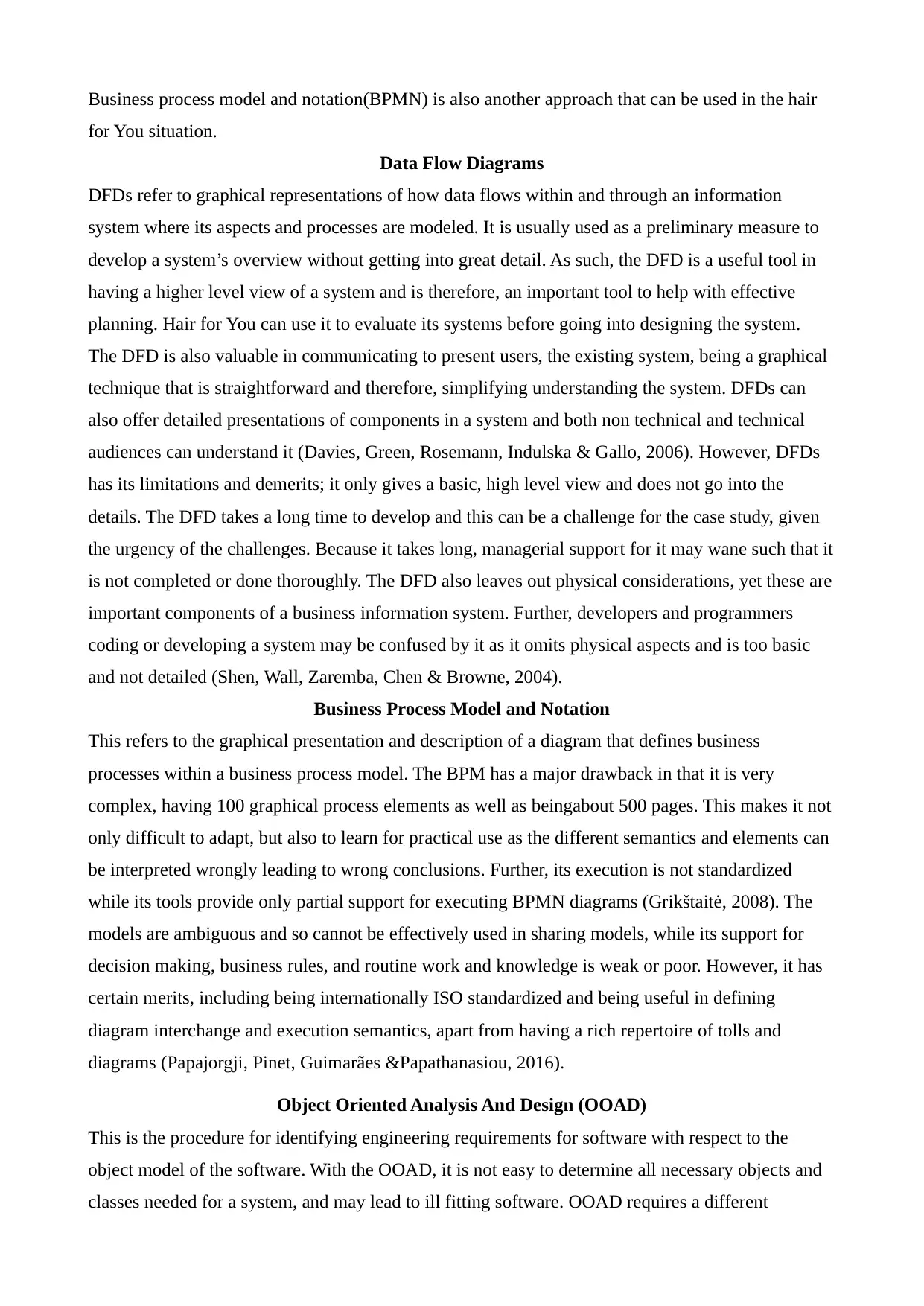
Business process model and notation(BPMN) is also another approach that can be used in the hair
for You situation.
Data Flow Diagrams
DFDs refer to graphical representations of how data flows within and through an information
system where its aspects and processes are modeled. It is usually used as a preliminary measure to
develop a system’s overview without getting into great detail. As such, the DFD is a useful tool in
having a higher level view of a system and is therefore, an important tool to help with effective
planning. Hair for You can use it to evaluate its systems before going into designing the system.
The DFD is also valuable in communicating to present users, the existing system, being a graphical
technique that is straightforward and therefore, simplifying understanding the system. DFDs can
also offer detailed presentations of components in a system and both non technical and technical
audiences can understand it (Davies, Green, Rosemann, Indulska & Gallo, 2006). However, DFDs
has its limitations and demerits; it only gives a basic, high level view and does not go into the
details. The DFD takes a long time to develop and this can be a challenge for the case study, given
the urgency of the challenges. Because it takes long, managerial support for it may wane such that it
is not completed or done thoroughly. The DFD also leaves out physical considerations, yet these are
important components of a business information system. Further, developers and programmers
coding or developing a system may be confused by it as it omits physical aspects and is too basic
and not detailed (Shen, Wall, Zaremba, Chen & Browne, 2004).
Business Process Model and Notation
This refers to the graphical presentation and description of a diagram that defines business
processes within a business process model. The BPM has a major drawback in that it is very
complex, having 100 graphical process elements as well as beingabout 500 pages. This makes it not
only difficult to adapt, but also to learn for practical use as the different semantics and elements can
be interpreted wrongly leading to wrong conclusions. Further, its execution is not standardized
while its tools provide only partial support for executing BPMN diagrams (Grikštaitė, 2008). The
models are ambiguous and so cannot be effectively used in sharing models, while its support for
decision making, business rules, and routine work and knowledge is weak or poor. However, it has
certain merits, including being internationally ISO standardized and being useful in defining
diagram interchange and execution semantics, apart from having a rich repertoire of tolls and
diagrams (Papajorgji, Pinet, Guimarães &Papathanasiou, 2016).
Object Oriented Analysis And Design (OOAD)
This is the procedure for identifying engineering requirements for software with respect to the
object model of the software. With the OOAD, it is not easy to determine all necessary objects and
classes needed for a system, and may lead to ill fitting software. OOAD requires a different
for You situation.
Data Flow Diagrams
DFDs refer to graphical representations of how data flows within and through an information
system where its aspects and processes are modeled. It is usually used as a preliminary measure to
develop a system’s overview without getting into great detail. As such, the DFD is a useful tool in
having a higher level view of a system and is therefore, an important tool to help with effective
planning. Hair for You can use it to evaluate its systems before going into designing the system.
The DFD is also valuable in communicating to present users, the existing system, being a graphical
technique that is straightforward and therefore, simplifying understanding the system. DFDs can
also offer detailed presentations of components in a system and both non technical and technical
audiences can understand it (Davies, Green, Rosemann, Indulska & Gallo, 2006). However, DFDs
has its limitations and demerits; it only gives a basic, high level view and does not go into the
details. The DFD takes a long time to develop and this can be a challenge for the case study, given
the urgency of the challenges. Because it takes long, managerial support for it may wane such that it
is not completed or done thoroughly. The DFD also leaves out physical considerations, yet these are
important components of a business information system. Further, developers and programmers
coding or developing a system may be confused by it as it omits physical aspects and is too basic
and not detailed (Shen, Wall, Zaremba, Chen & Browne, 2004).
Business Process Model and Notation
This refers to the graphical presentation and description of a diagram that defines business
processes within a business process model. The BPM has a major drawback in that it is very
complex, having 100 graphical process elements as well as beingabout 500 pages. This makes it not
only difficult to adapt, but also to learn for practical use as the different semantics and elements can
be interpreted wrongly leading to wrong conclusions. Further, its execution is not standardized
while its tools provide only partial support for executing BPMN diagrams (Grikštaitė, 2008). The
models are ambiguous and so cannot be effectively used in sharing models, while its support for
decision making, business rules, and routine work and knowledge is weak or poor. However, it has
certain merits, including being internationally ISO standardized and being useful in defining
diagram interchange and execution semantics, apart from having a rich repertoire of tolls and
diagrams (Papajorgji, Pinet, Guimarães &Papathanasiou, 2016).
Object Oriented Analysis And Design (OOAD)
This is the procedure for identifying engineering requirements for software with respect to the
object model of the software. With the OOAD, it is not easy to determine all necessary objects and
classes needed for a system, and may lead to ill fitting software. OOAD requires a different
Paraphrase This Document
Need a fresh take? Get an instant paraphrase of this document with our AI Paraphraser
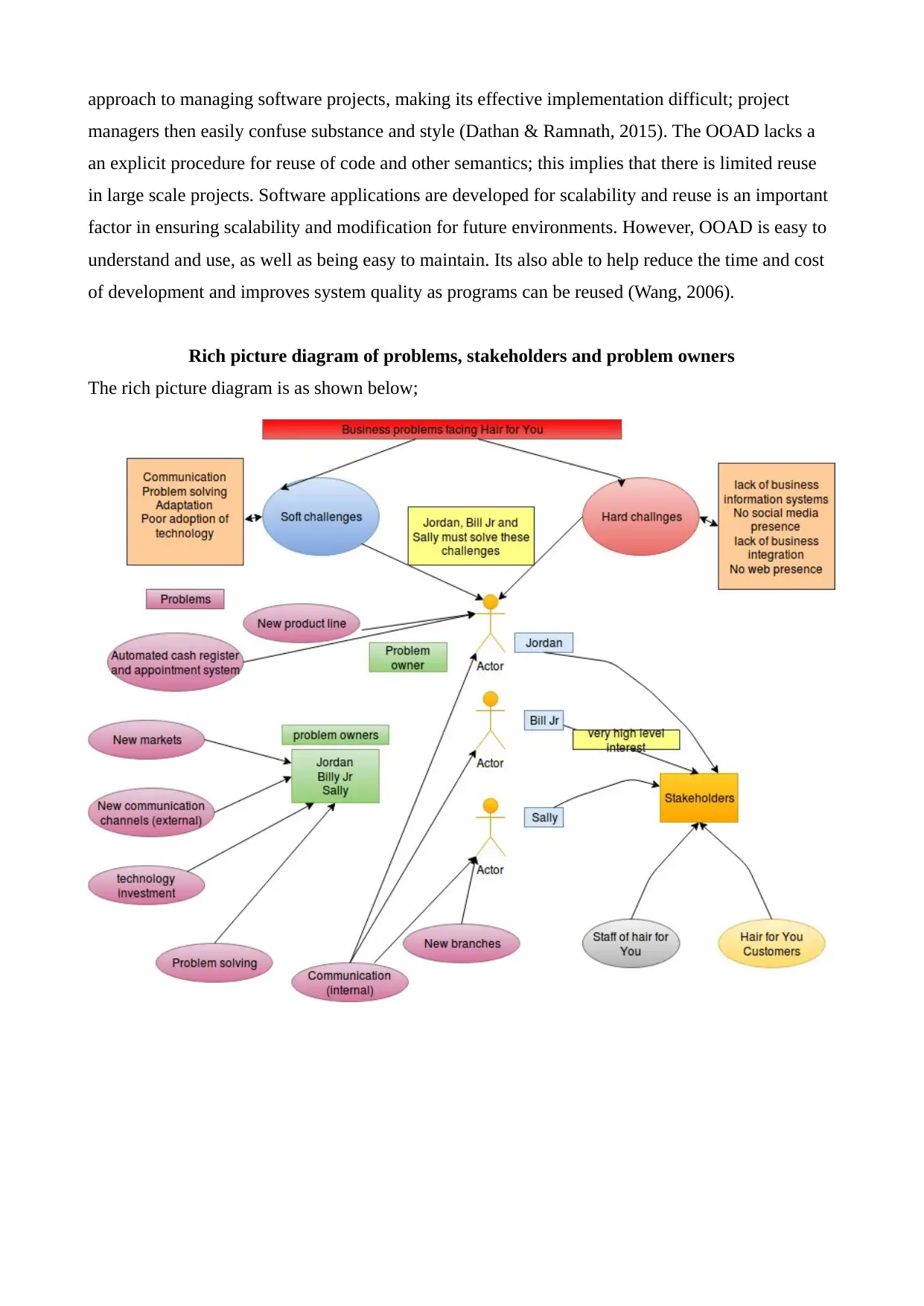
approach to managing software projects, making its effective implementation difficult; project
managers then easily confuse substance and style (Dathan & Ramnath, 2015). The OOAD lacks a
an explicit procedure for reuse of code and other semantics; this implies that there is limited reuse
in large scale projects. Software applications are developed for scalability and reuse is an important
factor in ensuring scalability and modification for future environments. However, OOAD is easy to
understand and use, as well as being easy to maintain. Its also able to help reduce the time and cost
of development and improves system quality as programs can be reused (Wang, 2006).
Rich picture diagram of problems, stakeholders and problem owners
The rich picture diagram is as shown below;
managers then easily confuse substance and style (Dathan & Ramnath, 2015). The OOAD lacks a
an explicit procedure for reuse of code and other semantics; this implies that there is limited reuse
in large scale projects. Software applications are developed for scalability and reuse is an important
factor in ensuring scalability and modification for future environments. However, OOAD is easy to
understand and use, as well as being easy to maintain. Its also able to help reduce the time and cost
of development and improves system quality as programs can be reused (Wang, 2006).
Rich picture diagram of problems, stakeholders and problem owners
The rich picture diagram is as shown below;
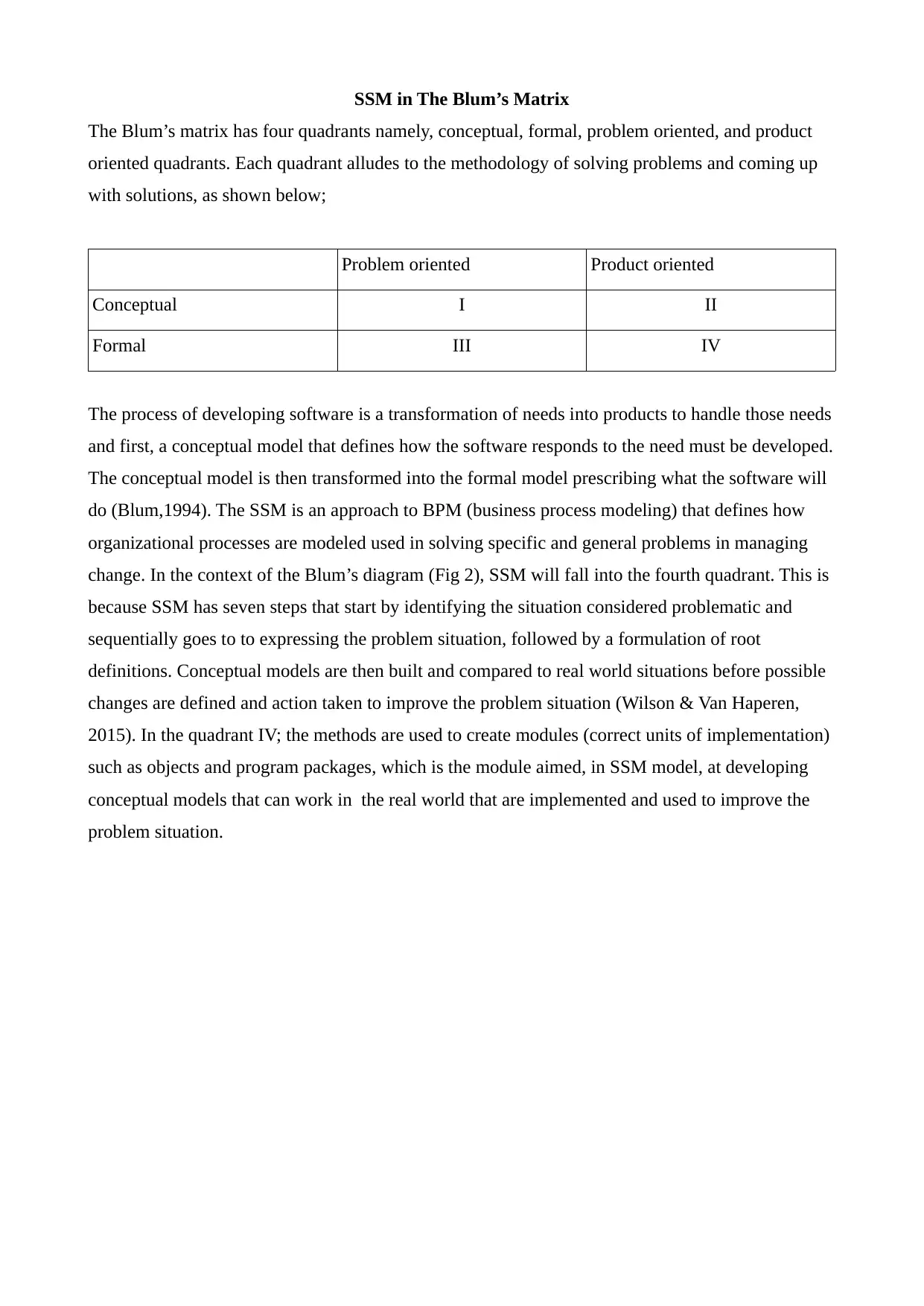
SSM in The Blum’s Matrix
The Blum’s matrix has four quadrants namely, conceptual, formal, problem oriented, and product
oriented quadrants. Each quadrant alludes to the methodology of solving problems and coming up
with solutions, as shown below;
Problem oriented Product oriented
Conceptual I II
Formal III IV
The process of developing software is a transformation of needs into products to handle those needs
and first, a conceptual model that defines how the software responds to the need must be developed.
The conceptual model is then transformed into the formal model prescribing what the software will
do (Blum,1994). The SSM is an approach to BPM (business process modeling) that defines how
organizational processes are modeled used in solving specific and general problems in managing
change. In the context of the Blum’s diagram (Fig 2), SSM will fall into the fourth quadrant. This is
because SSM has seven steps that start by identifying the situation considered problematic and
sequentially goes to to expressing the problem situation, followed by a formulation of root
definitions. Conceptual models are then built and compared to real world situations before possible
changes are defined and action taken to improve the problem situation (Wilson & Van Haperen,
2015). In the quadrant IV; the methods are used to create modules (correct units of implementation)
such as objects and program packages, which is the module aimed, in SSM model, at developing
conceptual models that can work in the real world that are implemented and used to improve the
problem situation.
The Blum’s matrix has four quadrants namely, conceptual, formal, problem oriented, and product
oriented quadrants. Each quadrant alludes to the methodology of solving problems and coming up
with solutions, as shown below;
Problem oriented Product oriented
Conceptual I II
Formal III IV
The process of developing software is a transformation of needs into products to handle those needs
and first, a conceptual model that defines how the software responds to the need must be developed.
The conceptual model is then transformed into the formal model prescribing what the software will
do (Blum,1994). The SSM is an approach to BPM (business process modeling) that defines how
organizational processes are modeled used in solving specific and general problems in managing
change. In the context of the Blum’s diagram (Fig 2), SSM will fall into the fourth quadrant. This is
because SSM has seven steps that start by identifying the situation considered problematic and
sequentially goes to to expressing the problem situation, followed by a formulation of root
definitions. Conceptual models are then built and compared to real world situations before possible
changes are defined and action taken to improve the problem situation (Wilson & Van Haperen,
2015). In the quadrant IV; the methods are used to create modules (correct units of implementation)
such as objects and program packages, which is the module aimed, in SSM model, at developing
conceptual models that can work in the real world that are implemented and used to improve the
problem situation.
⊘ This is a preview!⊘
Do you want full access?
Subscribe today to unlock all pages.

Trusted by 1+ million students worldwide
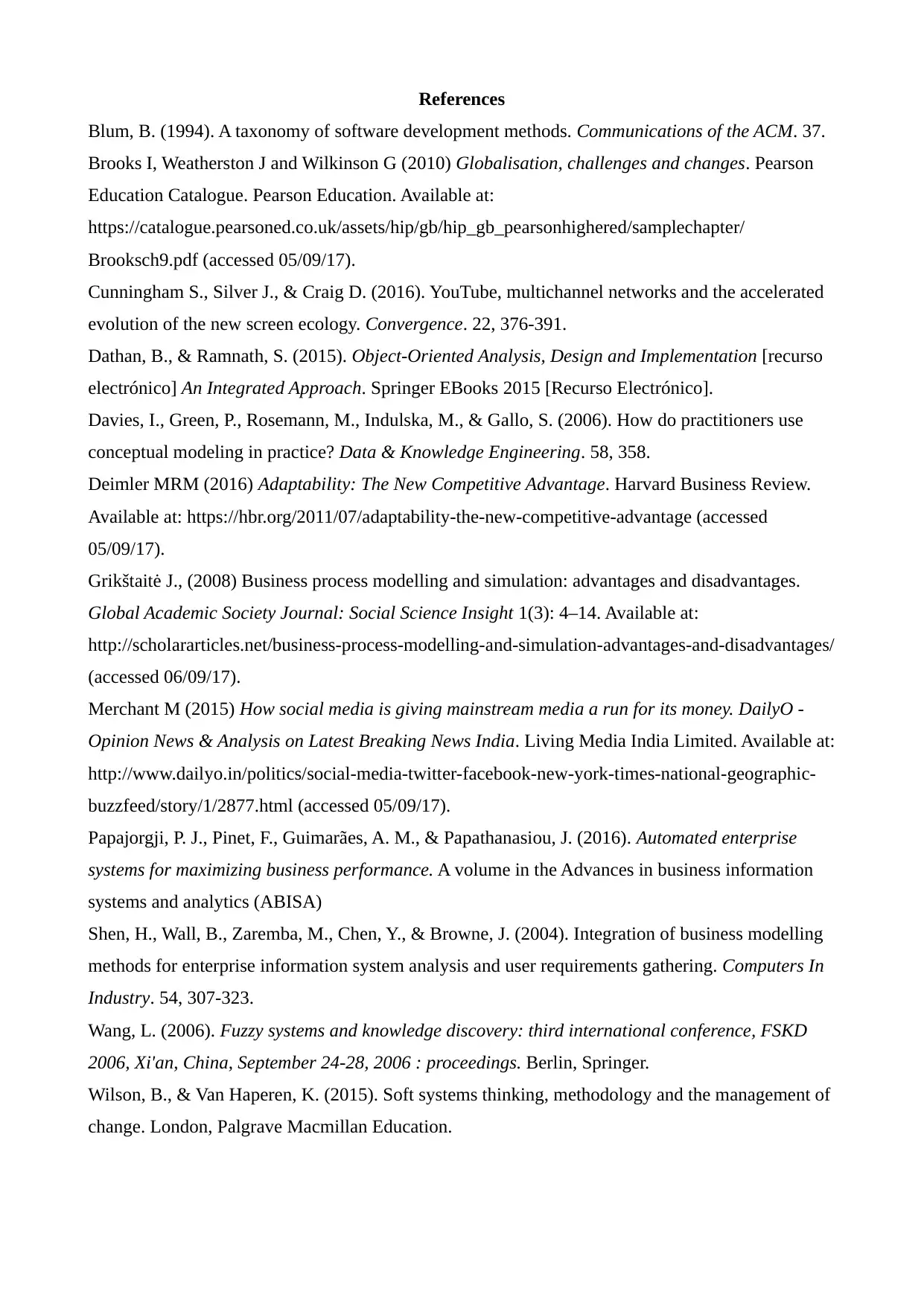
References
Blum, B. (1994). A taxonomy of software development methods. Communications of the ACM. 37.
Brooks I, Weatherston J and Wilkinson G (2010) Globalisation, challenges and changes. Pearson
Education Catalogue. Pearson Education. Available at:
https://catalogue.pearsoned.co.uk/assets/hip/gb/hip_gb_pearsonhighered/samplechapter/
Brooksch9.pdf (accessed 05/09/17).
Cunningham S., Silver J., & Craig D. (2016). YouTube, multichannel networks and the accelerated
evolution of the new screen ecology. Convergence. 22, 376-391.
Dathan, B., & Ramnath, S. (2015). Object-Oriented Analysis, Design and Implementation [recurso
electrónico] An Integrated Approach. Springer EBooks 2015 [Recurso Electrónico].
Davies, I., Green, P., Rosemann, M., Indulska, M., & Gallo, S. (2006). How do practitioners use
conceptual modeling in practice? Data & Knowledge Engineering. 58, 358.
Deimler MRM (2016) Adaptability: The New Competitive Advantage. Harvard Business Review.
Available at: https://hbr.org/2011/07/adaptability-the-new-competitive-advantage (accessed
05/09/17).
Grikštaitė J., (2008) Business process modelling and simulation: advantages and disadvantages.
Global Academic Society Journal: Social Science Insight 1(3): 4–14. Available at:
http://scholararticles.net/business-process-modelling-and-simulation-advantages-and-disadvantages/
(accessed 06/09/17).
Merchant M (2015) How social media is giving mainstream media a run for its money. DailyO -
Opinion News & Analysis on Latest Breaking News India. Living Media India Limited. Available at:
http://www.dailyo.in/politics/social-media-twitter-facebook-new-york-times-national-geographic-
buzzfeed/story/1/2877.html (accessed 05/09/17).
Papajorgji, P. J., Pinet, F., Guimarães, A. M., & Papathanasiou, J. (2016). Automated enterprise
systems for maximizing business performance. A volume in the Advances in business information
systems and analytics (ABISA)
Shen, H., Wall, B., Zaremba, M., Chen, Y., & Browne, J. (2004). Integration of business modelling
methods for enterprise information system analysis and user requirements gathering. Computers In
Industry. 54, 307-323.
Wang, L. (2006). Fuzzy systems and knowledge discovery: third international conference, FSKD
2006, Xi'an, China, September 24-28, 2006 : proceedings. Berlin, Springer.
Wilson, B., & Van Haperen, K. (2015). Soft systems thinking, methodology and the management of
change. London, Palgrave Macmillan Education.
Blum, B. (1994). A taxonomy of software development methods. Communications of the ACM. 37.
Brooks I, Weatherston J and Wilkinson G (2010) Globalisation, challenges and changes. Pearson
Education Catalogue. Pearson Education. Available at:
https://catalogue.pearsoned.co.uk/assets/hip/gb/hip_gb_pearsonhighered/samplechapter/
Brooksch9.pdf (accessed 05/09/17).
Cunningham S., Silver J., & Craig D. (2016). YouTube, multichannel networks and the accelerated
evolution of the new screen ecology. Convergence. 22, 376-391.
Dathan, B., & Ramnath, S. (2015). Object-Oriented Analysis, Design and Implementation [recurso
electrónico] An Integrated Approach. Springer EBooks 2015 [Recurso Electrónico].
Davies, I., Green, P., Rosemann, M., Indulska, M., & Gallo, S. (2006). How do practitioners use
conceptual modeling in practice? Data & Knowledge Engineering. 58, 358.
Deimler MRM (2016) Adaptability: The New Competitive Advantage. Harvard Business Review.
Available at: https://hbr.org/2011/07/adaptability-the-new-competitive-advantage (accessed
05/09/17).
Grikštaitė J., (2008) Business process modelling and simulation: advantages and disadvantages.
Global Academic Society Journal: Social Science Insight 1(3): 4–14. Available at:
http://scholararticles.net/business-process-modelling-and-simulation-advantages-and-disadvantages/
(accessed 06/09/17).
Merchant M (2015) How social media is giving mainstream media a run for its money. DailyO -
Opinion News & Analysis on Latest Breaking News India. Living Media India Limited. Available at:
http://www.dailyo.in/politics/social-media-twitter-facebook-new-york-times-national-geographic-
buzzfeed/story/1/2877.html (accessed 05/09/17).
Papajorgji, P. J., Pinet, F., Guimarães, A. M., & Papathanasiou, J. (2016). Automated enterprise
systems for maximizing business performance. A volume in the Advances in business information
systems and analytics (ABISA)
Shen, H., Wall, B., Zaremba, M., Chen, Y., & Browne, J. (2004). Integration of business modelling
methods for enterprise information system analysis and user requirements gathering. Computers In
Industry. 54, 307-323.
Wang, L. (2006). Fuzzy systems and knowledge discovery: third international conference, FSKD
2006, Xi'an, China, September 24-28, 2006 : proceedings. Berlin, Springer.
Wilson, B., & Van Haperen, K. (2015). Soft systems thinking, methodology and the management of
change. London, Palgrave Macmillan Education.
1 out of 7
Related Documents
Your All-in-One AI-Powered Toolkit for Academic Success.
+13062052269
info@desklib.com
Available 24*7 on WhatsApp / Email
![[object Object]](/_next/static/media/star-bottom.7253800d.svg)
Unlock your academic potential
Copyright © 2020–2025 A2Z Services. All Rights Reserved. Developed and managed by ZUCOL.





